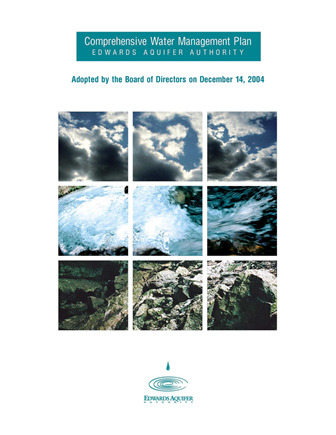Comprehensive Water Management Plan Edwards Aquifer Authority

| Author | Edwards Aquifer Authority |
| Year | 2004 |
| Description | Edward Aquifer Authority’s Comprehensive Water Management Plan as required by Section 1.25 of the Edwards Aquifer Authority Act, for 2000-2030. |
| Publisher | Edwards Aquifer Authority |
| Location | Edwards Aquifer Authority Jurisdiction |
| Cover | View Download |
| File | View Download |
| Summary |
|
OVERVIEW OF PLAN DEVELOPMENT Discussions with the CWMP Work Group, the Aquifer Management Planning Committee of the board, and the CWMP Stakeholder Group revealed that a duplicative planning effort for a major component of the CWMP, the 20-year water supply plan, was being conducted by the South Central Texas Regional Water Planning Group (SCTRWPG). In order to avoid duplication, the Authority agreed to delay development of the CWMP pending the development of the SCTRWPG regional water supply plan. Additionally, to facilitate regional cooperation, the Authority modified the water supply component of the CWMP to 30-years from the original 20-years stipulated in the Act. Legal challenges to the Authority’s rules and subsequent changes further delayed the development of the CWMP. In 2001, the development of the Authority’s five-year Strategic Plan took priority and completion of the CWMP was deferred pending its adoption in April 2002. OVERVIEW OF THE PLAN In addition to federally endangered and threatened species concerns, another challenge that the plan addresses is the increasing water demand from a rapidly growing population. Coupled with these issues, the plan also addresses the mandate for the Authority to restrict permitted pumpage from the Edwards Aquifer to 450,000 acre-feet per year through December 2007. In addition, the Authority is required to reduce permitted pumpage to 400,000 acre-feet per year beginning in January 2008. The planning area is projected to have an overall increase of approximately 34 percent in water demand from 2000 to 2030. Bexar County alone has projected an increase of more than one-half million people during this 30-year planning period, attributed primarily to the growth of San Antonio and surrounding suburban areas. Managing the aquifer as the major component of meeting the water supply needs of this relatively large influx of people into the planning area will be one of the greatest challenges faced by the Authority in the coming years. Section 7.0 of this plan describes the various water management plans and programs developed by the Authority. The current water management strategies include: Research supports the Authority’s planning process. Section 9.0 describes the ongoing planning processes that include: The CWMP will be evaluated annually and a report presented to the Authority’s Board of Directors (board). Revisions and modifications will be determined by the development of new data regarding management of the aquifer, legislative changes that affect the Authority, and policy directions of the board. |
Search for Documents
Advance Search
Explore EAA's Scientific Reports
- All Reports
- History
- Groundwater Recharge, Recharge Zone
- Groundwater Movement
- Geomorphology and Caves
- Weather Modification
- Geology
- Water Use and Conservation
- Geochemistry
- Water Resources Planning and Management
- Floods and Drought
- Water Quality
- Climatology
- Surface Water / Groundwater Relationship
- Biology
- Springs, Groundwater Discharge
- Archaeology
- RZ Protection
- Aquifer Levels
- Remote Sensing
- Precipitation
- Overview Studies
- Modeling
- Hydrology and Hydrogeology
